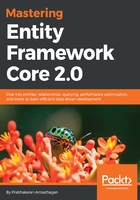
Installing Entity Framework
The Entity Framework package inclusion and the steps involved were also discussed extensively in Chapter 1, Kickstart - Introduction to Entity Framework Core. So let's focus on the packages that are required for the reverse engineering (database-first approach). The basic package required for the Entity Framework to integrate with SQL Server is as follows:
Add the following command in the PM Console to install the following package:
Install-Package Microsoft.EntityFrameworkCore.SqlServer
We could also search and install the Microsoft.EntityFrameworkCore.SqlServer package using NuGet Package Manager window:

Microsoft.EntityFrameworkCore.SqlServer NuGet package
The packages required for the reverse engineering (auto-generating the models from the database) are listed below, we could add the following command in the PM Console to install these packages:
Install-Package Microsoft.EntityFrameworkCore.Tools
Install-Package Microsoft.EntityFrameworkCore.SqlServer.Design
We could also search and install the preceding listed packages using NuGet Package Manager window as shown here:

Microsoft.EntityFrameworkCore.Tools NuGet package
Install the Microsoft.EntityFrameworkCore.Tools package. This package exposes the Entity Framework commands to the NuGet Package Manager console, with which we could perform certain operations such as scaffolding database context:

Microsoft.EntityFrameworkCore.SqlServer.Design NuGet package
Install the Microsoft.EntityFrameworkCore.SqlServer.Design package. This package lets us scaffold the models from the SQL Server database.
At the time of writing, Microsoft.EntityFrameworkCore.SqlServer.Design 2.0.0 was available only as a preview release.
We have installed the packages required to reverse engineer the existing database entities in EF Core. In the next section, we will start reverse engineering to configure EF Core against the database.